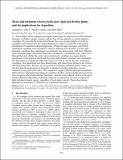Mean and turbulent velocity fields near rigid and flexible plants and the implications for deposition
Author(s)
Ortiz, Alejandra Campbell; Ashton, Andrew; Nepf, Heidi
DownloadNepf_Mean and.pdf (1.699Mb)
PUBLISHER_POLICY
Publisher Policy
Article is made available in accordance with the publisher's policy and may be subject to US copyright law. Please refer to the publisher's site for terms of use.
Terms of use
Metadata
Show full item recordAbstract
The transport of fine sediment and organic matter plays an important role in the nutrient dynamics of shallow aquatic systems, and the fate of these particles is closely linked to vegetation. We describe the mean and turbulent flow near circular patches of synthetic vegetation and examine how the spatial distribution of flow is connected to the spatial distribution of suspended sediment deposition. Patches of rigid, emergent, and flexible, submerged vegetation were considered, with two different stem densities. For the rigid emergent vegetation, flow adjustment was primarily two-dimensional, with flow deflected in the horizontal plane. Horizontal shear layers produced a von Kármán vortex street. Flow through the patch shifted the vortex street downstream, resulting in a region directly downstream of the patch in which both the mean and turbulent velocities were diminished. Net deposition was enhanced within this region. In contrast, for the flexible, submerged vegetation, flow adjustment was three-dimensional, with shear layers formed in the vertical and horizontal planes. Because of strong vertical circulation, turbulent kinetic energy was elevated directly downstream of the patch. Consistent with this, deposition was not enhanced at any point in the wake. This comparison suggests that morphological feedbacks differ between submerged and emergent vegetation. Further, enhanced deposition occurred only in regions where both turbulent and mean velocities were reduced, relative to the open channel. Reduced deposition (indicating enhanced resuspension) occurred in regions of high turbulence kinetic energy, regardless of local mean velocity. These observations highlight the importance of turbulence in controlling deposition.
Date issued
2013-12Department
Massachusetts Institute of Technology. Department of Civil and Environmental EngineeringJournal
Journal of Geophysical Research: Earth Surface
Publisher
John Wiley & Sons, Inc/American Geophysical Union
Citation
Ortiz, Alejandra C., Andrew Ashton, and Heidi Nepf. “Mean and Turbulent Velocity Fields Near Rigid and Flexible Plants and the Implications for Deposition.” Journal of Geophysical Research: Earth Surface 118, no. 4 (December 2013): 2585–2599.
Version: Final published version
ISSN
21699003